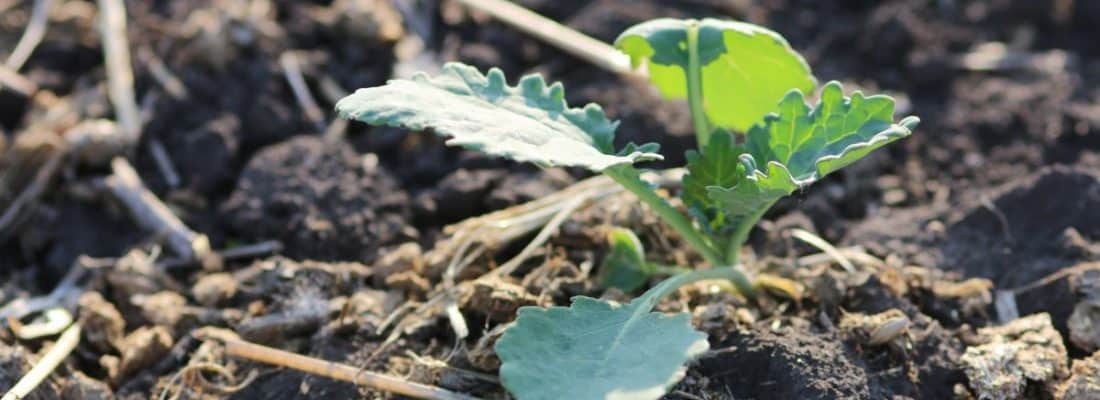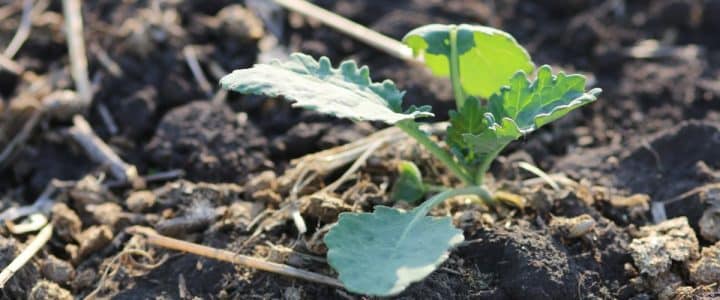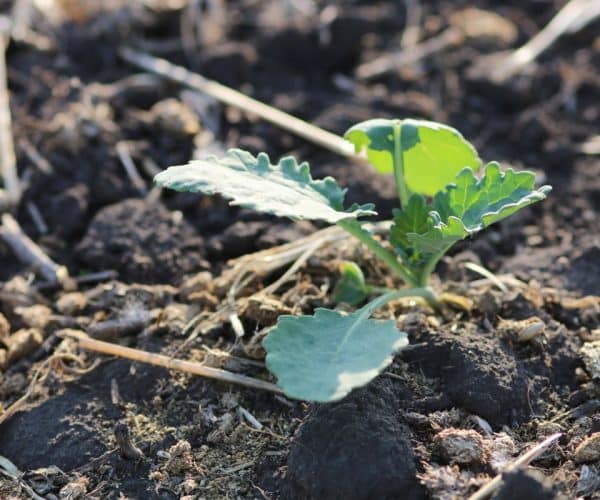4R Nutrient Stewardship is an internationally recognized program that advocates for responsible and effective management of nutrient resources. The 4Rs stand for the Right source of fertilizer used at the Right rate, at the Right time and in the Right place. 4R best management practices are economically, socially and environmentally beneficial.
Overview
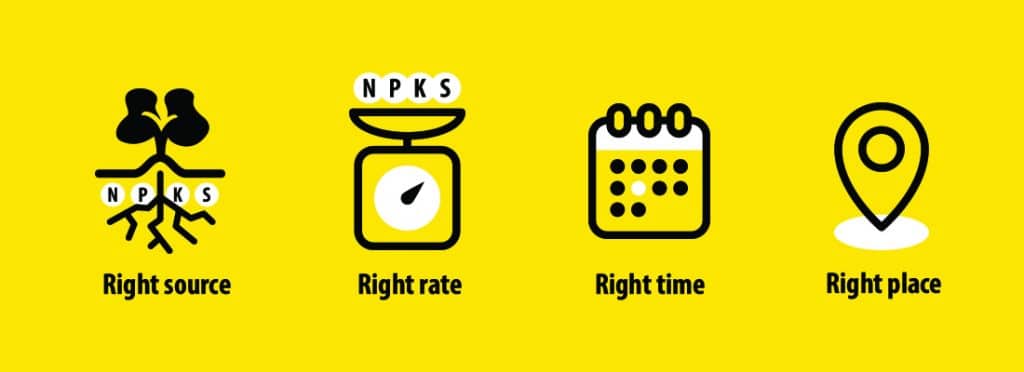
Using the 4Rs (the Right Source at the Right Rate, Right Time and Right Place) helps crop producers minimize the losses of nutrients and environmental concerns, while maximizing the crop’s access to the nutrients and related profitability.
The 4Rs are highly intertwined and allow for agile decision making to maximize resources and manage challenges of growing crops such as canola (i.e., when one practice may not be an option, there are ways to compensate by looking at the 4Rs collectively).
To let research help inform canola nutrient management options, visit the Canola Research Hub.
Why does it matter?
Fertilizer is the biggest expense in canola production. By using 4R Nutrient Stewardship, farmers can ensure they use fertilizer efficiently and get more return from the investment. Learn more in the Canola Digest article The ROI For 4R.
Canada’s canola industry sees a lot of potential for 4R Nutrient Stewardship for land enhancements, profitability improvements and proactively showing our customers and their governments our emphasis on sustainability. As a result, Canada’s canola industry has a goal to utilize 4R Nutrient Stewardship practices on 90 per cent of canola acres by 2025. For further details, read about the Keep it Coming 2025 strategic plan.
Using 4R practices to improve nutrient use efficiency is part of an overall strategy to profitably increase yield of canola while improving environmental sustainability to meet growing global market demand.
By working with 4R designated agronomists, and having your acres enrolled in 4R Nutrient Stewardship, growers can be recognized for these practices. For an example, read the Canola Digest article on how Cargill’s agronomy technology lead for Western Canada supports using 4R to help show end users and consumers how modern agriculture can help the planet.
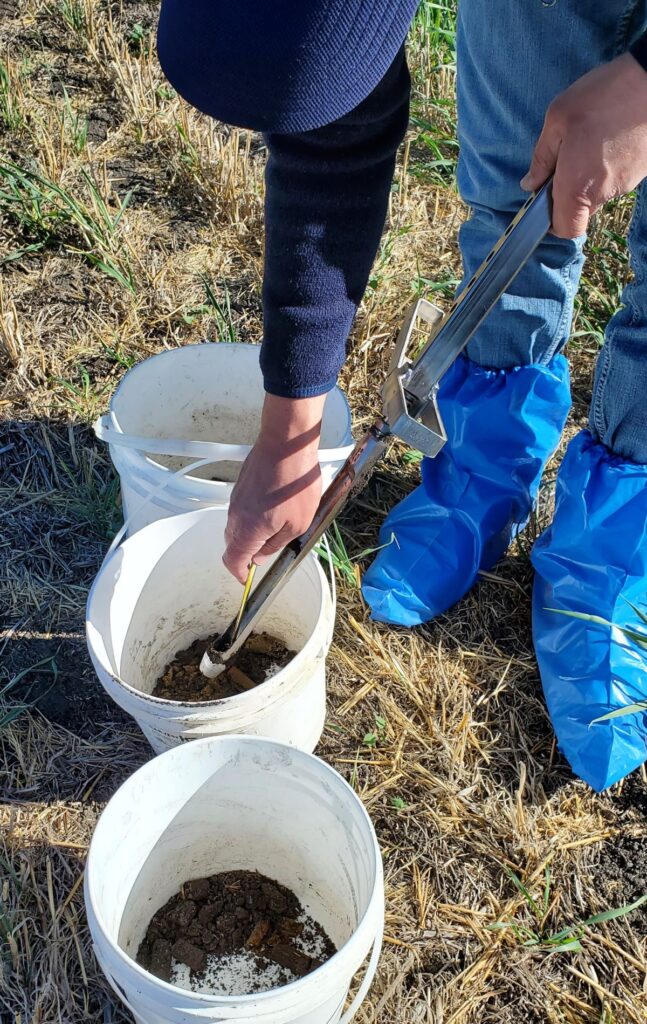
Does 4R impact yield and economics?
Fertilizer Canada’s 2023 Fertilizer Use: Western Canada survey found that 61.6% of farmers said an “increase in economic return” was a benefit of having a 4R plan in place. Interestingly, in the same survey, 25.6% of respondents listed “cost” as a reason for not putting a 4R plan in place and 33.3% listed “cost” as a reason for not adopting 4R practices. This could be due to the anticipated increase in labour, time or equipment required. This survey also reported that farmers with the greatest canola yields were those that were very familiar with the 4R program, compared to farmers that were somewhat or not familiar with it.
Practices that would require investment are setting crop and field-specific nitrogen rates using appropriate regional tools such as nitrate soil tests, nitrogen balance, response curves or provisional guidelines, and accessing the appropriate equipment to apply the fertilizer. Learn more about farmers using 4R to increase their profitability in this Canola Digest article.
Fertilizer Canada’s 2020 Fertilizer Use: Western Canada survey found that 50.6 per cent of high-yield growers soil test for nitrogen every year. That compares to 29.5 per cent for moderate-yield growers and 24.4 per cent for low-yield growers. High-yield growers also tended to be more familiar with 4R programming and are more likely to work with a 4R designated agronomist. Review additional survey highlights in this Canola Digest article.
How to get started
Many growers unknowingly follow 4R practices because of the inherent benefits associated with proper nutrient management.
The 4R Nutrient Stewardship program is a formal way for growers to participate and implement the 4Rs on their farm and be recognized for doing so. By working with a 4R designated agronomist to develop and execute a 4R plan, the designated agronomist will submit 4R acres on a grower’s behalf, which allows for these best management practices to be accounted for and recognized.
To learn more, read the following Canola Watch fundamentals article on How to get acres counted as 4R.
To find your local 4R agri-retailer and more information on the 4R Nutrient Stewardship program, visit the Fertilizer Canada website.
What do the 4Rs mean for canola nutrient management?
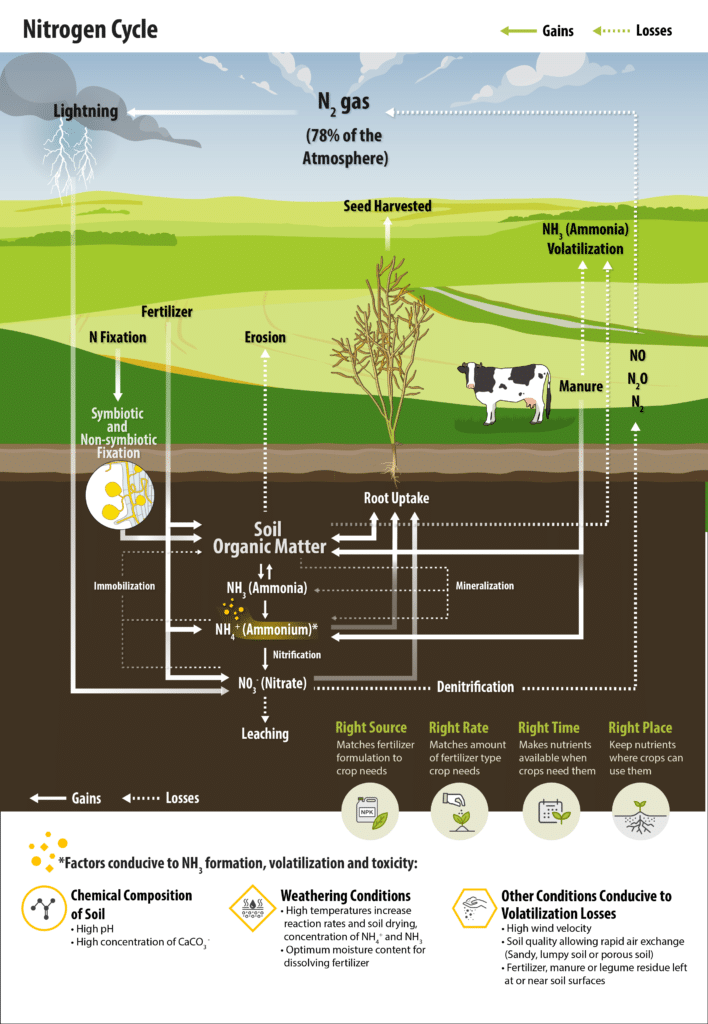
The Right source of fertilizer is influenced not only by the other Rs, but also by environmental conditions. There are many fertilizer products and formulations available for growers to choose from, and the timing and placement of the fertilizer can impact which source is the most acceptable. When it comes to following 4R Nutrient Stewardship principles, an example of the Right source is using products such as urea (46-0-0) or anhydrous ammonia (82-0-0) in properly-timed fall banding applications, rather than products such as urea ammonium nitrate (28-0-0), which is more prone to losses based on its nitrate content. If spring banding is chosen as the application method, then all forms of nitrogen become viable options.
Enhanced efficiency fertilizers
Enhanced efficiency fertilizers (EEFs) protect nitrogen from losses and reduce nitrous oxide emissions 1 so more of the applied nitrogen fertilizer ends up in plants, not the atmosphere. EEFs come in three main forms: urease inhibitors, nitrification inhibitors and controlled-release nitrogen. They provide the biggest benefit when soils have excess moisture 2.
- Nitrification inhibitors are the most effective for reducing nitrous oxide emissions.
- Urease inhibitors slow the conversion of urea to ammonium and reduce volatilization losses, and in certain circumstances will have more value from an overall profitability perspective.
- Controlled-release nitrogen has a polymer-coating that slows the release of urea so it more closely matches crop uptake.
As noted in this Canola Digest article, farms will want to review how each EEF fits best within their systems. Often a urease inhibitor or nitrification inhibitor used individually is the right balance for profitability and nitrogen loss management, however combination products that include both treatments are covered in Fertilizer Canada’s The Economics of 4R BMP Implementation and Emissions Reductions from Fertilizer report.
4R Right source practices
The following basic 4R Right source practices for spring cereal, oilseed and pulse rotations on the Canadian Prairies are from Table 4 of Fertilizer Canada’s 4R Practices Guidance document, which also features intermediate and advanced practices:
Nitrogen management practices:
- Ammonium-based formulations for fall (UAN excluded due to nitrate content).
- Any nitrogen fertilizer in spring or in-season.
Phosphorus management practice:
- Use phosphorus fertilizer with guaranteed analysis.
To learn more about the nitrogen cycle and potential mechanisms that cause losses, visit the Nitrogen cycling entry in the Canola Encyclopedia.
The Right rate means using the right amount of fertilizer to achieve an appropriate yield target based on your field’s productivity. When determining the Right rate, each field should be treated independently of other fields. While it may not be feasible to use a fertilizer blend specific to each field, using a common blend for all canola fields on a farm operation, and varying the application rate based on individual field yield targets, is one way to tailor the fertilizer application to each field.
Soil testing
To determine appropriate fertilizer rates, soil testing is recommended to help estimate available nutrients in the soil 3. Using these results, along with your canola field’s nutrient requirements to meet the yield goal, you can determine the amount of fertilizer required to meet the needs of your canola crop. Read more in the Canola Digest article Soil sampling as a step towards improved land use.
Soil testing is a relatively easy practice that doesn’t require a large investment. For more information on soil testing, visit the Identifying Nutrient Requirements entry in the Canola Encyclopedia or read the Canola Watch The right time for soil sampling fundamentals article.
Variable rate
Variable rate nutrient management helps manage the variability within fields by applying the amount of nutrients required for the differing production zones within the field. It may not reduce overall nitrogen rates, but it applies nitrogen in a way that can increase overall yield and nitrogen use efficiency. Costs include zone-based soil testing, seeding tools that can apply variable rate fertilizer and variable rate maps. Soil tests and prescription mapping are relatively low costs compared to seeding tools, but many new seeding tools are variable-rate capable. Read more in this Canola Digest article.
Sectional control
Sectional control can also help maintain yield while reducing overlaps and therefore reducing costs (less seed and nitrogen applied) and nitrogen losses (from unused nitrogen or emissions) and increasing profitability, efficiency and sustainability 4 5.
4R Right rate practices
The following basic 4R Right rate practices for spring cereal, oilseed and pulse rotations on the Canadian Prairies are from Table 4 of Fertilizer Canada’s 4R Practices Guidance document, which also features intermediate and advanced practices.
Nitrogen management practices:
- Set crop and field specific nitrogen rates using appropriate regional tools such as nitrate soil tests (surface and subsurface sampling recommended) nitrogen balance, response curves or provincial guidelines.
- Consider field specific yield history and soil types in relation to yield potential of other fields on farm and in region, and probabilities for weather variations when setting rates.
Phosphorus management practices:
- Use recent soil test (three years or less) to establish phosphorus baseline.
- Follow provincial guidelines based on soil and crop types to meet sufficiency levels.
- Set field specific rates considering differences in yield potential and soil test values among fields.
- Adopt draw down strategy in fields that test very high in phosphorus (approaching or exceeding 60 ppm) by setting rates less than annual crop removal.
To learn more on canola’s overall fertilizer needs, read the Canola Watch How much fertilizer does canola need? fundamentals article.
The Right time for fertilizer application is generally as close to the time of crop uptake as possible. For canola, this would mean spring and early summer applications which reduce the amount of time between fertilizer application and when the crop needs the nutrients. Due to logistical constraints, this may not always be feasible, but shifts from fall to spring application, when suitable, can provide 4R advantages. Spring application tends to reduce losses and increase yields compared to fall application in general, based on Prairie research 6 7. While 4R recommends late-fall banding over fall broadcasting, any fall application is subject to higher losses when soils are wet in the spring.
Another option is using split applications with one in-crop application, when suitable to the growing season. This could include fall banding or pre-seed and in-crop top-dress applications. However, precipitation is required to move nutrients like nitrogen or sulphur into the root zone, and therefore the best timing for in-crop applications could be just prior to an adequate rainfall.
Economic disadvantages of spring application can include cost of fertilizer, slower spring seeding operation because of fill times and required investment in machinery that can apply seed and fertilizer in one pass with spatial separation between seed and fertilizer, as noted in this Canola Digest article.
Not all nutrients will have the same flexibility of application timings, so planning fertilizer applications early in season, at seeding for example, is one of the more common practices. One application time to avoid regardless of the fertilizer source you choose is when the ground is snow covered and frozen. Winter applications are prone to high losses, therefore will not maximize the economic return of input expenses and are less environmentally responsible.
4R Right time practices
The following basic 4R Right time practices for spring cereal, oilseed and pulse rotations on the Canadian Prairies are from Table 4 of Fertilizer Canada’s 4R Practices Guidance document, which also feature intermediate and advanced practices.
These nitrogen management practices:
- Apply nitrogen after soil cools in fall; or
- Apply nitrogen in spring before or at seeding.
- No nitrogen application on frozen soil and/or snow-covered ground.
These phosphorus management practices:
- Apply phosphorus in spring at or before seeding.
- Apply phosphorus in fall with incorporation or band or co-band.
To learn more about fall, spring and in-crop nitrogen applications, visit the Timing of application section in the Canola Encyclopedia and the Tips to apply nitrogen and sulphur in season Canola Watch fundamentals article.
Subsurface fertilizer applications, or banding, has benefits 2 compared to surface applications, such as broadcasting 8. First, they are placed in the root zone, where plants can utilize the nutrients. Second, fertilizer that is in the soil is much less prone to losses than if it were on the soil surface.
Deep banding (7.5-10 cm or 3-4”) urea produced lower emissions than the shallow banding (2-2.5 cm or 1”) in a 3-year, 6-site study on light textured soils in Manitoba 1 and another 3-year study in Manitoba 7.
For phosphorous, side-banding or seed-placing (or a combination of both) during seeding is advised rather than broadcasting, as well 9. Foliar applications for phosphorus fertilizer are not a good alternative 10
One exception is elemental sulphur which needs to oxidize on the soil surface to become a plant available form. Also, while there are logistical advantages to growers broadcasting nutrients such as nitrogen as their method of placement, the risks of losses are higher. If broadcasting is the chosen method, then using enhanced efficiency fertilizers as the Right source is the best option. This reinforces that fact that the 4Rs are influenced by one another, and a proper plan will look at both the trade-offs and complements each R has on its counterparts.
4R Right place practices
The following basic 4R Right place practices for spring cereal, oilseed and pulse rotations on the Canadian Prairies are from Table 4 of Fertilizer Canada’s 4R Practices Guidance document, which also feature intermediate and advanced practices.
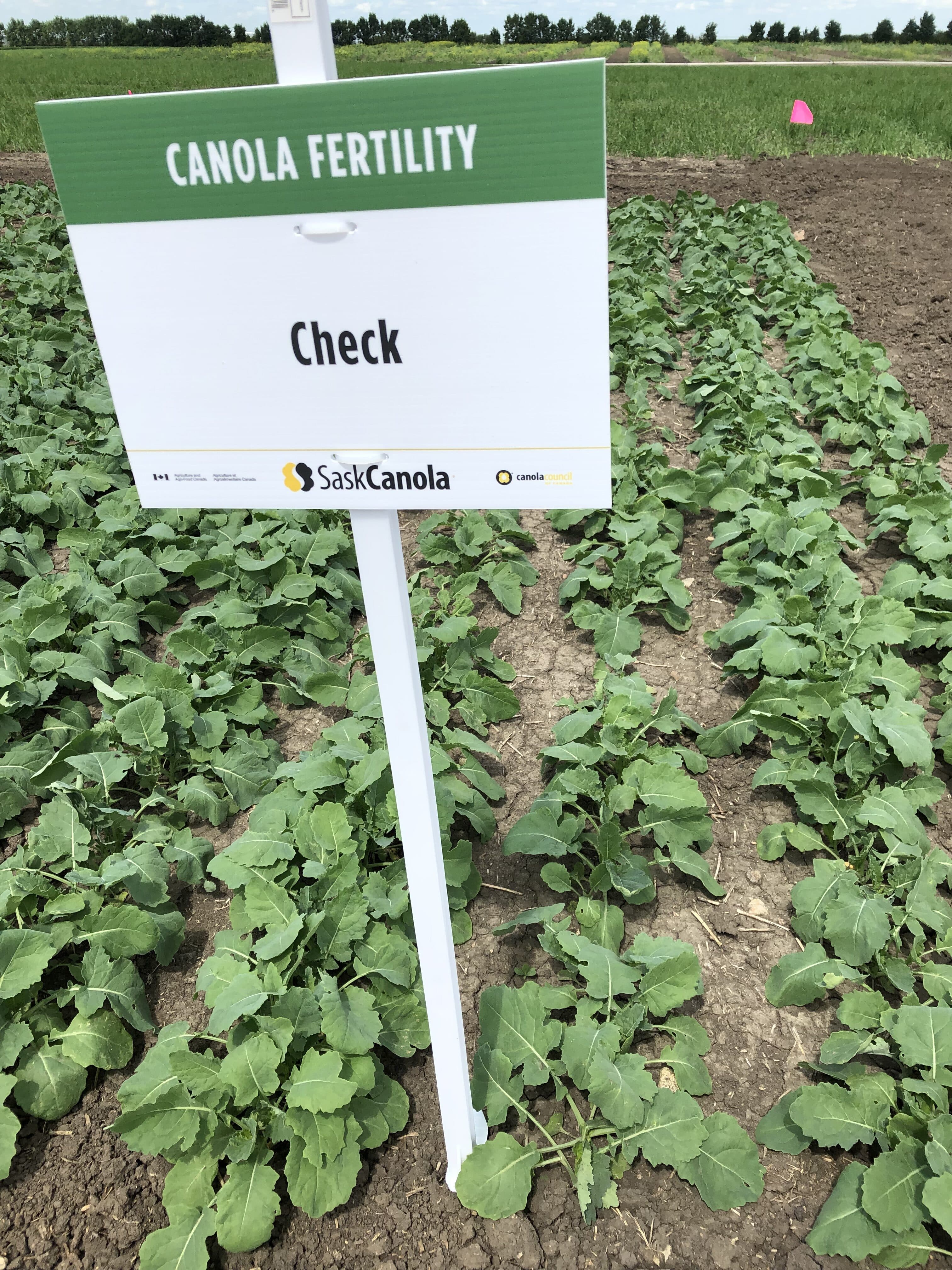
These nitrogen management practices:
- Apply in subsurface bands/ injection any acceptable time.
- Broadcast and incorporate in spring.
- Avoid fall broadcast of unprotected nitrogen.
- Fall broadcast of enhanced efficiency nitrogen fertilizers are acceptable following label instructions regarding incorporation and timing.
- Fall broadcast nitrogen applied as MAP or DAP with incorporation is acceptable.
These phosphorus management practices:
- Place with seed at safe rates based on crop, seed bed utilization, and total product load.
- Side-band at seeding.
- Band or co-band prior to seeding or mid-row band at seeding (with consideration for mobility issues if banded with high rates of nitrogen or in cool soils).
- Surface apply in fields with limited risk of movement to surface waters.
To learn more about nitrogen fertilizer placement options, visit the Placement of fertilizer section in the Canola Encyclopedia and the Choose the right placement for nitrogen and phosphorus fertilizer applications Canola Research Hub blog.
Further interest
Learn how farmers are using soil samples, split applications, EEFs and other 4R practices to lower risks while also maximizing potential returns in the Canola Digest article How to increase yield with fertilizer.
For canola nutrient questions and inquiries related to 4R Nutrient Stewardship practices, contact Warren Ward, agronomy specialist and canola nutrient management lead with the Canola Council of Canada.
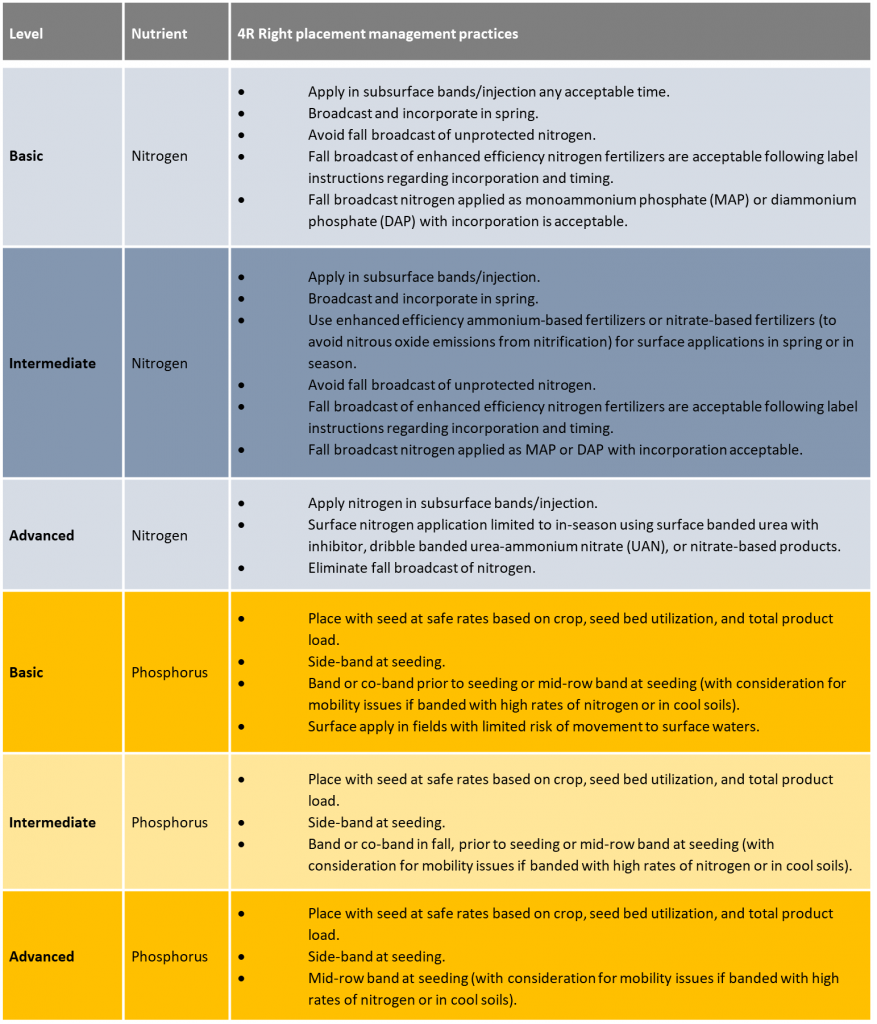
Footnotes
- Tenuta, M. & Gao, X. 2022. Optimal source, placement and application timing for yield and reduction of greenhouse gas footprint for canola production on light texture soils. Available on the Canola Research Hub.[↩][↩]
- Holzapfel, C. 2017. Demonstrating 4R nitrogen principles in canola. Available on the Canola Research Hub.[↩][↩]
- Holzapfel, C. 2018. Demonstrating 4R nitrogen management principles for canola. Available on the Canola Research Hub.[↩]
- Blechinger (Gaetz), K. & Grieger, L. 2020. Evaluation of emission reductions and cost saving in sectional control air seeders, drills and sowing equipment across the Canadian Prairies (Phase 1). Available on the Canola Research Hub.[↩]
- Blechinger (Gaetz), K. & Lung, B. 2020. Evaluation of emission reductions and cost saving in sectional control air seeders, drills and sowing equipment across the Canadian Prairies (Phase 2). Available on the Canola Research Hub.[↩]
- Grant, C. A., Brown, K. R., Racz, G. J. & Bailey, L. D. 2002. Influence of source, timing and placement of nitrogen fertilization on seed yield and nitrogen accumulation in the seed of canola under reduced- and conventional-tillage management. Canadian Journal of Plant Science, 82, 629–638.[↩]
- Tenuta, M. & Baron, K. 2017. Canola response and minimizing nitrogen losses in two-pass seeding-fertilization systems with varying placement methods in Manitoba. Available on the Canola Research Hub.[↩][↩]
- Mohr, R. 2019. Impact of source and placement of nitrogen and sulphur fertilizers on canola. Available on the Canola Research Hub.[↩]
- Holzapfel, C. 2017. Demonstrating 4R phosphorus principles in canola. Available on the Canola Research Hub.[↩]
- Schoenau, J. & Froese, S. 2018. Crop response to foliar-applied phosphorus fertilizers. Available on the Canola Research Hub.[↩]
